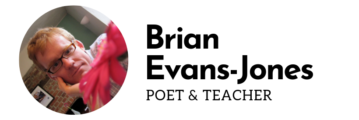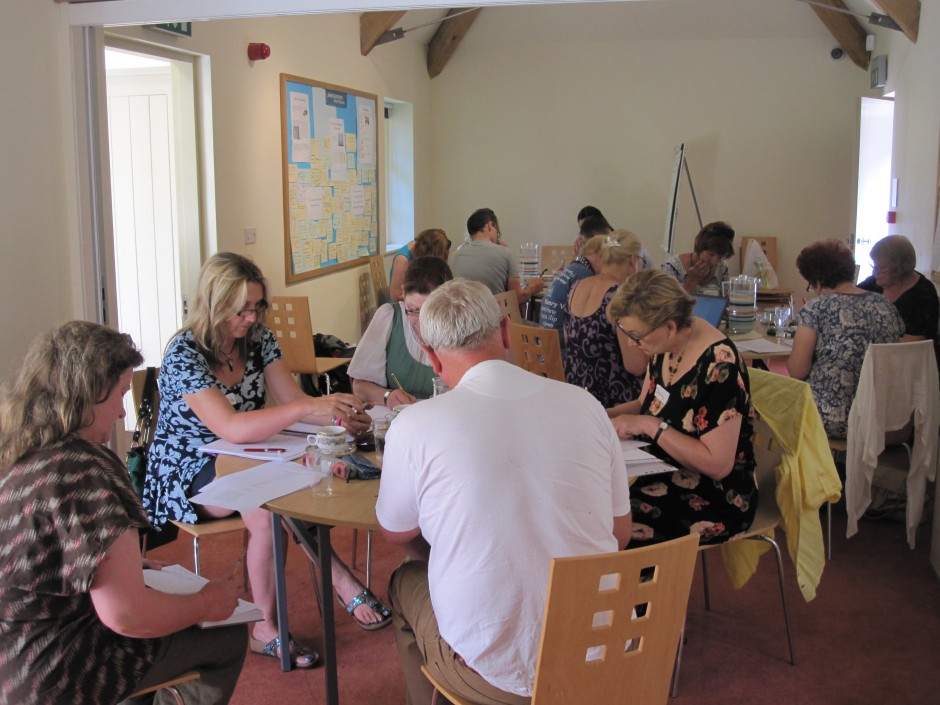Last Saturday, a group of 15 intrepid poets braved the hottest day of the year so far to join me at the Jane Austen House Museum, Chawton, for my first workshop there. The reason for our gathering was the Museum’s ‘Impressions’ exhibition: works by 7 Hampshire-based artists, commissioned to celebrate the bicentenary of Pride and Prejudice. I always enjoy writing about art – ekphrasis is the technical term – and running workshops that are ‘ekphratic’ (which may be a term I’ve just invented), so I was looking forward to it very much.
The Museum is a lovely place, especially when the weather is good enough to enjoy the garden. The House is filled with Austen information and artefacts, and has a decorous, 18th-century sort of charm. And at the moment the ‘Impressions’ exhibition adds another fascinating dimension to the experience. My job was to help the writers create poems which responded to the art in the exhibition: in other words, responding to the responses. So what with the setting, the history, and the art at our disposal, I had a feeling it was going to be a really good day.
We started off in the Museum’s purpose-built education centre, which (as you can see above) is very comfortable base for a workshop, especially with tea and biscuits freely dished out! After getting to know each other a bit, I introduced the exhibition and the idea of poetry inspired by art. This is a huge and varied field, but we just had time for a whistle-stop tour through a few different approaches, from the descriptive/moralising method of Keats (Austen’s contemporary) looking at his ‘Grecian Urn’, to the more austere modernism of William Carlos Williams looking at Brueghel, and UA Fanthorpe and Eavan Boland doing it their ways.
My favourite poem of this stage was Yusef Komunyakaa’s ‘Facing It‘: an extremely moving response to the Vietnam War Memorial. I love the expert blending of its elements: details of the monument itself, the poet’s own involvement with it (‘I’m inside’), hints of the war whose dead it commemorates, and interactions between the monument and its context (the ‘plane’ which happens to fly over, the woman who seems to be trying to rub out names). I thought this suited the conditions of the ‘Impressions’ art very well, since there was an intriguing interaction between the artworks, the rooms in which they were displayed, and the process of viewing them. The artists have responded in hugely varied ways to Austen’s life, her work as a writer, and the present-day importance of her books, and the interfaces between 21st-century art, 17th-century house, and 18th/9th-century furnishings are captivating. Add to that the experience of viewing them surrounded by other visitors, and it was rich food for creativity. Here’s a pic of Alex Jones’s ‘Icarus Descended’, from the Courtyard:
Then we went round the house, everyone looking for piece of art (or something else in the house) to respond to. Pretty soon people started reappearing in the classroom with intently furrowed brows and busy pencils. After a little guidance from me on things to think about and include – content and form – there was a very intense period of scribbling from everyone, despite the increasing heat.
After lunch and some time for sharing poems so far, I asked everyone to write about the process by which the art was made – either the ‘Impressions’ art or Austen’s novels themselves. I used two poems by Philip Gross as examples, from the fascinating poetry/photography collaboration I Spy Pinhole Eye: poems in which he considers either how a pinhole camera’s image forms, or how he as a poet could try to borrow the pinhole camera’s method. To be honest I had thought that by this stage everyone would be somewhat dozy in the heat, but again the concentration and the results were impressive (more tea doubtless helped).
That just left time for some more sharing of work, and then it was over. There were many fabulous poems drafted, and if you go to the Museum while ‘Impressions’ is on, you should be able to find a booklet of some of them to read for yourself.
Many thanks to everyone who came (including one person from Kazakhstan, via Birmingham), and I’m looking forward to trying a Mansfield Park-themed workshop next year!



This was an excellent workshop in which we had to react to artwork rather quickly and then we wrote 2 poems under timed conditions. I knew from experience that writing under pressure focuses the mind brilliantly.
Many thanks to Brian who orchestrated the workshop sensitively, with a bit of stimulation from established poets, some guidance on writing and excellent overall management. Exchanging ideas and listening to other participants’ poems was also an integral part of the workshop for me.
Needless to say the ambience of Jane Austen’s House Museum and the way the artwork was placed contributed greatly to us being inspired by the very varied artistic works.
Thanks for commenting Ilse – glad you enjoyed it.